Early childhood education is a common-sense investment
- July 5, 2016
- / Reggie Dogan
- / education

Keetsa McKeithen reads to her 3 year old class at T.R. Jackson Pre-K center Thursday February 11, 2016 in Milton, Florida. Photo credit: Michael Spooneybarger.
Most people pay little attention to the stock market except on days when the market comes tumbling down. For investors, last month’s stock market crash was bad news.
While nobody can predict when stocks will tank, we all know that markets, like the oceans, ebb and flow. But there’s one investment that we can be sure of and it pays dividends for a lifetime.
The National Education Association maintains that high-quality childhood education represents one of the best investments we can make. Empirical research consistently shows that providing a high-quality education for children before they turn five yields significant long-time benefits.
In a report on its website, it says, the “NEA believes it’s a common-sense investment we can’t pass up.”
To be sure, kindergarten is a hot-button issue. From the White House to the state house to the schoolhouse, people are talking about ways to help young children prepare for the rigors of school before they reach kindergarten.
An important predictor of a child’s success in school is the quality of preschool education he or she receives.
Research consistently shows that children who participated in a high-quality early education program had higher IQs and test scores in math and reading during elementary and secondary school, were less likely to repeat grades and were placed in fewer special education classes.
Among the goals of the Studer Community Institute is to improve the community’s overall quality of life, and an critical part of it includes having children ready and prepared for school.
Of nearly 3,000 kindergartners in Escambia County schools this year, more than one-third of them — about 1,000 children — were not prepared academically or socially for kindergarten, based on data analysis by the Florida Office of Early Learning.
In its policy brief, the NEA President Dennis Van Roekel said he is greatly concerned about the growing number of children who enter kindergarten already behind their peers socially and academically.
“Evidence suggests this “school readiness” gap begins before children enter school and place children at risk of failure in school,” Van Roekel said. “The Association believes all children deserves access to early learning opportunities that will increase their chances for success in school and in life.”
Expanding access to and investing in early learning and high-quality preschool programs provides a win-win solution: improve outcomes for children, defray costs for low-income working families and prepare our future workforce for economic competiveness, all while saving taxpayers money in the long run.
But instead of investing more to help prepare children, we have pulled back on early childhood programs.
Because of cutbacks and stagnant funding, fewer children receive childcare assistance today than two decades ago. Today’s infants and toddlers are bearing the brunt of inequality and soaring child poverty rates.
Two randomized controlled trials, or RCTs, have been conducted to measure the effects of high-quality early childhood education.
The Perry Preschool Project in Michigan and the Carolina Abecedarian Project in North Carolina follow participants to measure long-term effects of things like incarceration rates, teen pregnancy, average education level, average income, among other things. Both projects found huge economic and social gains to high-quality preschool.
They mirror studies that show for every dollar invested in the early education of a child, $16 is saved in social service spending.
The NEA puts a lot of stock in early education. It urges all states in the U.S. to make high quality early childhood education programs a priority and consider them an integral part of the education system. In its long-reaching commitment to improve early education, NEA recommends, among other things:
— Free, publicly funded, quality kindergarten programs in all states.
— Mandatory, full-day kindergarten. Only 14 states require districts to offer full-day kindergarten.
— Optional free, publicly funded, quality “universal” pre-kindergarten programs for all three- and four-year-old children whose parents choose to enroll them.
— Federal funds to make pre-kindergarten programs available for all 3- and 4-year-old children from disadvantaged families. State and local governments should provide the additional funds necessary to make pre-kindergarten available for all 3- and 4-year-olds.
—Dedicated funding for early childhood education. Public schools should be the primary provider of pre-kindergarten programs, and additional funding must be allocated to finance them in the same manner as K-12 schools.
In short, high-quality prekindergarten pays for itself, and in the long run it benefits public balance sheets, children, their families, taxpayers and society as a whole.
That’s why the NEA believes policymakers should seriously consider a universal prekindergarten initiative as a sound public investment with long-term returns.
 CivicCon launches with a look at good growth in cities
CivicCon launches with a look at good growth in cities
 Building stronger brains one baby, one parent at a time
Building stronger brains one baby, one parent at a time
 SCI debuts commercial on Early Learning City
SCI debuts commercial on Early Learning City
 Entrecon: World class speakers and an opportunity to sharpen skills
Entrecon: World class speakers and an opportunity to sharpen skills
 PYP Quality of Life survey 2017
PYP Quality of Life survey 2017
 EntreCon Pensacola 2016: A look back
EntreCon Pensacola 2016: A look back
 Leadership tip: getting better employee takeaways
Leadership tip: getting better employee takeaways
 Leadership tip: be interested instead of interesting
Leadership tip: be interested instead of interesting
 Leadership tip: delivering difficult messages
Leadership tip: delivering difficult messages
 Brain Bags boost Arc, Early Childhood Court programs
Brain Bags boost Arc, Early Childhood Court programs